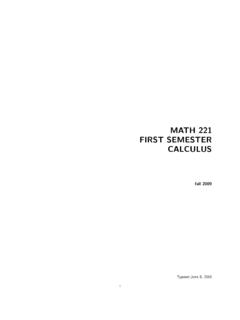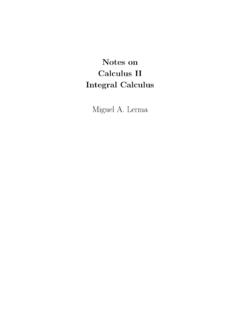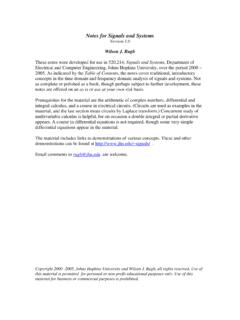Transcription of Fundamentals of Solid Mechanics
1 Fundamentals of Solid MechanicsCourse at the European School for Advanced Studies in Earthquake Risk Reduction(ROSE School), Pavia, ItalyKrzysztof WilmanskiUniversity of Zielona Gora, , historical sketch51 Modicum of vectors and Algebra .. Analysis .. 172 Geometry and kinematics of Preliminaries .. Reference configuration and Lagrangian description .. Displacement, velocity, Eulerian description .. Infinitesimal strains .. Compatibility conditions .. 403 Balance of mass and Conservation of mass .. Conservation of momentum .. Lagrangian description .. Eulerian description .. Moment of momentum .. Stress analysis .. 524 Thermodynamics of Energy conservation law.
2 Second law of thermodynamics .. 645 Elastic Non-linear elasticity .. Linear elasticity, isotropic and anisotropic materials .. Governing equations .. Navier-Cauchy equations, Green functions, displacement potentials Beltrami-Michell equations .. Plane strain and plane stress .. Waves in linear elastic materials .. Principle of virtual work .. Thermoelasticity .. Poroelasticity ..1116 Viscoelastic Viscoelastic fluids and solids .. Rheological models .. Three-dimensional viscoelastic model .. Differential constitutive relations .. Steady state processes and elastic-viscoelastic correspondence principle .. 1297 Introduction.
3 Plasticity of ductile materials .. Plasticity of soils .. Viscoplasticity ..1548 Introduction .. Continuum with dislocations .. On plasticity of metals .. Dislocations in geophysics .. 1659 Appendix: Green functions for isotropic elastic Purpose .. Statics of isotropic elastic materials .. Dynamic Green function for isotropic elastic materials.. 173 Introduction, historical sketchRemnants of old civil engineering constructions prove thatalready in ancient timesthe human being was able to build very complex structures. The old masters had bothexperience and intuition with which they were able to createthe most daring , they did not use in their work any theoretical models as we understand themtoday.
4 Most likely, it was first in XVI century that notions necessary for such a modelingwere da Vinci (1452-1519) sketched in his notebooks a possible test of the tensilestrength of a of Ctesiphon (the winter palace of Sassanids, Iraq) constructed in (left panel) and the dome of the Florence cathedral designed and builtby Filippo Brunelleschi in 1425 (right panel) two examplesof the earlyingenious constructions. In his book on mechanics1 Galileo (Galileo Galilei, 1564-1642) also dealt with thestrength of materials, founding that branch of science as well. He was the first to show1 Dialogo di Galileo Galilei Linceo Matematico Sopraordinario dello Studio di Pisa,in Florenza, Per Gio: Batista Landini MDCXXXII56 Introductionthat if a structure increased in all dimensions equally it would grow weaker at least hewas the first to explain the theoretical basis for this.
5 This is what is known as the square-cube law. The volume increases as the cube of linear dimensions but the strength onlyas the square. For that reason larger animals require proportionally sturdier supportsthan small ones. A deer expanded to the size of an elephant andkept in exact proportionwould collapse, its legs would have to be thickened out of proportion for proper support we mention only a few scientists whose contributions are particularly importantfor the development of continuum Mechanics at its early stage. Many further details canbe found in the article of J. R. Hooke is considered to be the founder of linear elasticity. He discovered in1660 (published in 1678), the observation that the displacement under a load was formany materials proportional to force.
6 However, he was not aware yet of the necessity ofterms of stress and strain. A similar discovery was made by (France, 1680).He described as well the explanation for the resistance of beams to transverse considered the existence of bending moments caused by transverse loadings and devel-oping extensional and compressional deformations, respectively, in material fibers alongupper and lower portions of beams. The first to introduce the relation between stressesand strains was the Swiss mathematician and mechanician Jacob Bernoulli (1654-1705).In his last paper of 1705 he indicated that the proper way of describing deformation wasto give force per unit area, stress, as a function of the elongation per unit length, strain, of a material fiber under tension.
7 Numerous mostimportant contributionswere made by the Swiss mathematician and mechanician Leonhard Euler (1707-1783),who was taught mathematics by Jacob brother Johann Bernoulli (1667-1748). Amongmany other ideas he proposed a linear relation between stress and strain in the form =E (1727). The coefficientEis now usually called Young s modulus after Englishnaturalist Thomas Young who developed a similar idea in the proposition of Jacob Bernoulli the notion that there is an internal tensionacting across surfaces in a deformed Solid has been commonlyaccepted. It was used, forexample, by German mathematician and physicist Gottfried Wilhelm Leibniz in introduced the idea that at a given section along the length of a beam there wereinternal tensions amounting to a net force and a net bending moment.
8 Euler introducedthe idea of compressive normal stress as the pressure in a fluid in French engineer and physicist Charles-Augustin Coulomb (1736-1806) was ap-parently the first to relate the theory of a beam as a bent elastic line to stress and strainin an actual beam. He discovered the famous expression =My/Ifor the stress due tothe pure bending of a homogeneous linear elastic beam; hereMis the bending moment,yis the distance of a point from an axis that passes through thesection centroid, parallelto the axis of bending, andIis the integral ofy2over the section area. The notion ofshear stress was introduced by French mathematician Parentin 1713. It was the workof Coulomb in 1773 to develop extensively this idea in connection with beams and withthe stressing and failure of soil.
9 He also studied frictional slip in most important and extensive contributions to the development of continuum2quotation from I. Asimov s Biographical Encyclopedia of Science and Technology, Doubleday, R. R ; Mechanics of Solids, published as a section of the article on Mechanics in the 1993printing of the 15th edition of Encyclopaedia Britannica (volume 23, pages 734 - 747 and 773), stem from the great French mathematician Augustin Louis Cauchy (1789-1857), originally educated as an engineer. In 1822 he formalized the stress concept inthe context of a general three-dimensional theory, showed its properties as consisting ofa 3 by 3 symmetric array of numbers that transform as a tensor,derived the equationsof motion for a continuum in terms of the components of stress, and gave the specificdevelopment of the theory of linear elastic response for isotropic solids.
10 As part of thiswork, Cauchy also introduced the equations which express the six components of strain,three extensional and three shear, in terms of derivatives of displacements for the casewhen all those derivatives are much smaller than unity; similar expressions had beengiven earlier by Euler in expressing rates of straining in terms of the derivatives of thevelocity field in a fluid this book we present a modern version of those models in which not only linearelastic but also viscoelastic and plastic materials are included. The full nonlinear theoryis not included but some of its basic notions such as Lagrangian and Eulerian descriptionsare the presentation we avoid many mathematical details in order to be understandablefor less mathematically skillful engineers and natural scientists.





